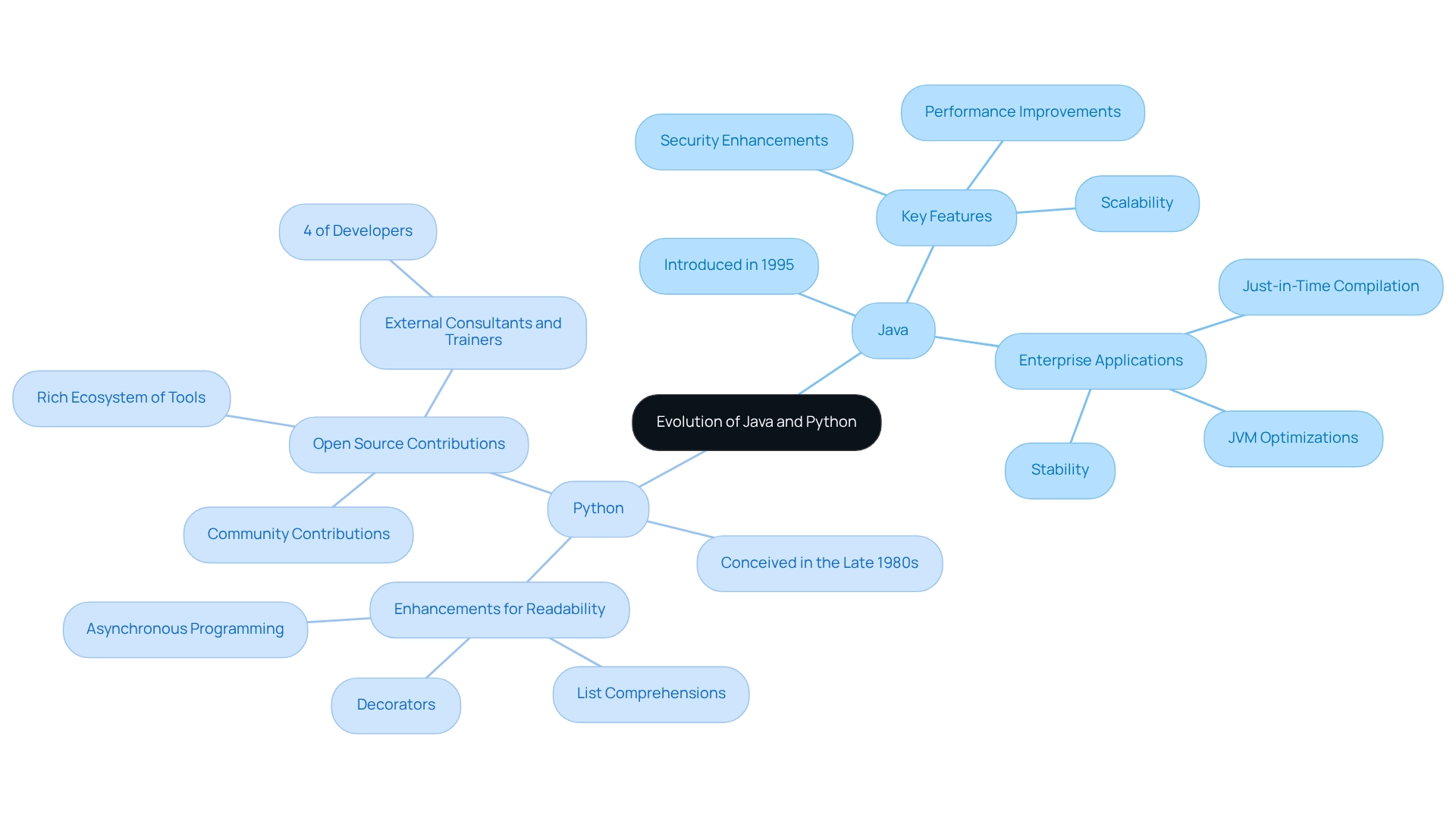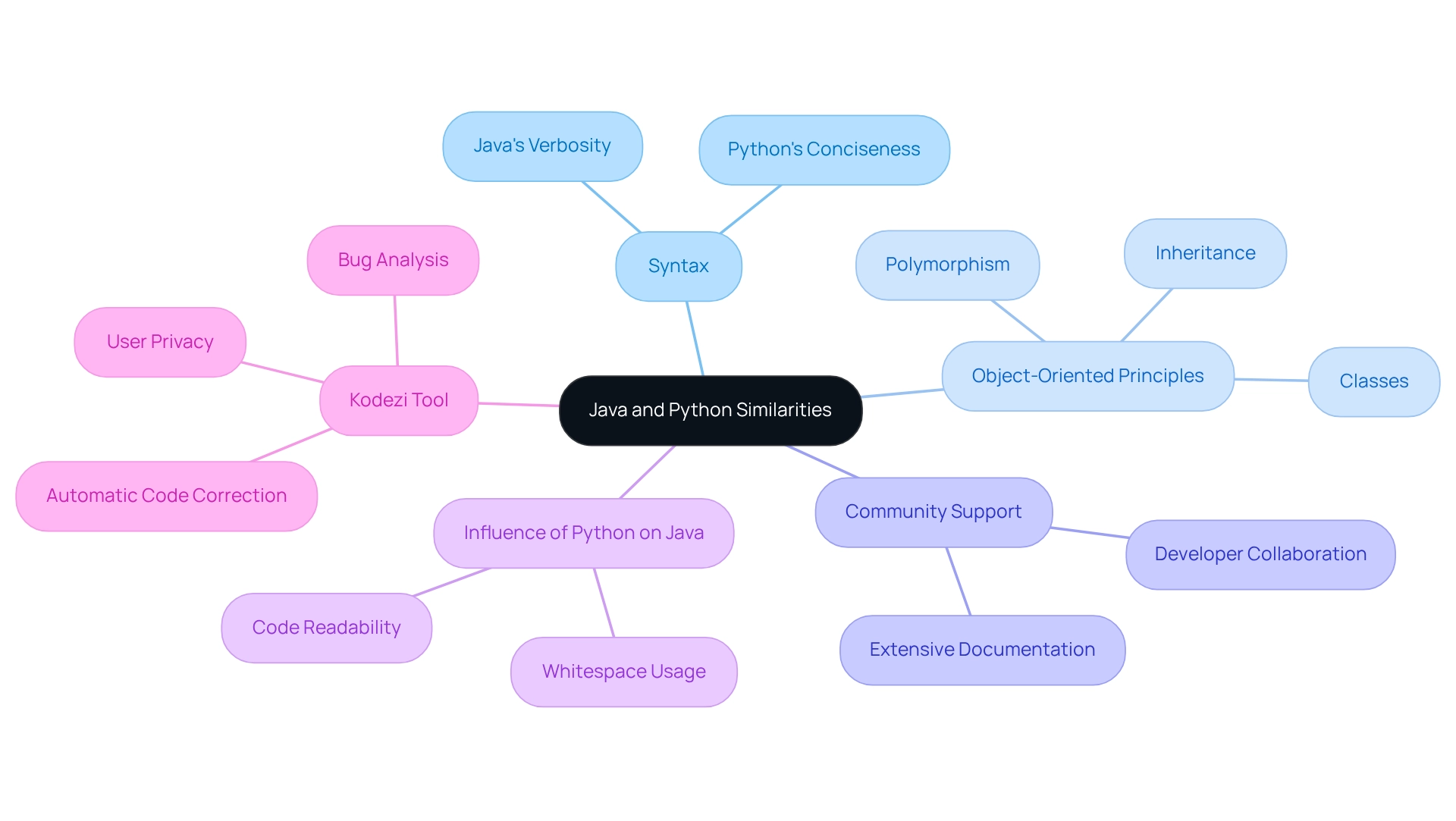Overview
Java and Python present notable similarities, especially in their object-oriented principles and the capability to produce modular, reusable code. Despite their differences in syntax and verbosity, both languages support similar control structures. Furthermore, they benefit from robust community support, enhancing their usability and fostering collaboration among developers. This shared foundation not only facilitates learning but also encourages developers to leverage the strengths of both languages in their projects.
Introduction
In the dynamic realm of programming, developers often encounter challenges that require robust solutions. Two languages stand out as titans of the tech landscape: Java and Python. Each has carved its niche, boasting unique features and capabilities that cater to diverse developer needs.
- Java, with its robust architecture and platform independence, remains a favorite for enterprise-level applications and Android development.
- In contrast, Python's simplicity and versatility have made it the go-to language for data science and rapid application development.
Understanding the core concepts, historical context, and practical applications of these languages is essential for any developer looking to navigate the complexities of modern programming. This exploration reveals not only the similarities and differences between these two giants but also how they shape the future of technology.
Define Java and Python: Core Concepts and Features
In the ever-evolving landscape of software development, developers often face significant coding challenges. How can these hurdles be effectively addressed? Enter Kodezi, a powerful coding tool designed to simplify the development process. With features like automated debugging and performance optimization, Kodezi enables developers to swiftly identify and rectify issues in their code, ensuring both efficiency and security compliance.
The benefits of using Kodezi are substantial. By streamlining the debugging process, developers can enhance their productivity and improve code quality. Imagine being able to detect problems in your code with just a few clicks—this is the efficiency that Kodezi brings to the table. Furthermore, the platform's extensive resources empower developers to elevate their coding skills, making it an invaluable asset in their toolkit.
As we reflect on the importance of programming languages in today's job market, it becomes clear that tools like Kodezi are instrumental in shaping developers' careers. With programming skills directly linked to improved income prospects, leveraging such tools can lead to significant professional growth. In addition, Kodezi acts as a 'Swiss-Army Knife for programmers,' providing a versatile solution to common coding issues.
So, why not explore the tools available on Kodezi? By embracing this innovative platform, you can transform your coding practices and achieve new heights in your development journey. After all, the right tools can make all the difference in navigating the complexities of software development.
Trace the Evolution of Java and Python: Historical Context
The programming language was introduced in 1995, originating from a project led by James Gosling and his team at Sun Microsystems. Initially intended for interactive television, it rapidly transformed into a robust programming language for web and enterprise applications. Over the years, this programming language has experienced numerous updates that have significantly enhanced its performance, security, and scalability. This solidifies its status as a favored option for large-scale systems and Android application development. Notably, Java's stability continues to make it a top contender for enterprise-level applications, and its execution speed has improved significantly with just-in-time compilation and JVM optimizations.
In contrast, the language was conceived in the late 1980s and officially released in 1991 as a successor to the ABC language. Its creator, Guido van Rossum, focused on enhancing code readability and simplicity. Van Rossum noted, "Its potential does seem limitless and only time will tell where it will head for next." The evolution of this programming language has been marked by the introduction of significant features such as list comprehensions, decorators, and asynchronous programming. These advancements have broadened its application in various domains, including data science, web development, and automation. Furthermore, the open-source characteristics of this programming language have fostered a collaborative development environment, leading to continuous improvements and a rich ecosystem of tools and libraries. This collaborative approach has been instrumental in the language's growth, with approximately 4% of its developers working as external consultants or trainers, further contributing to its widespread adoption.

Identify Key Similarities: Syntax, Object-Oriented Principles, and Community Support
Coding can often present developers with significant challenges, particularly when it comes to maintaining and organizing complex code. The question of whether Java and Python are similar arises as both are prominent object-oriented languages that utilize fundamental concepts such as classes, objects, inheritance, and polymorphism to structure their code effectively. This shared paradigm allows developers to create modular and reusable code, which greatly enhances maintainability. David Heinemeier Hansson emphasizes that compressing concepts enables the introduction of new ideas, a crucial aspect for both languages.
When we examine syntax, Java is generally more verbose, requiring explicit type declarations, while Python offers a more concise and readable syntax. Patrick Collison points out that coding is filled with peculiar concepts, and shorter, less descriptive names can lead to greater overall readability. Despite these syntactical differences, both languages support similar control structures, including loops and conditionals, which are vital for coding logic. This raises the question of how much Java and Python are similar, especially considering the robust community support for both languages, characterized by extensive documentation, libraries, and frameworks that streamline the development process. This collaborative environment fosters knowledge sharing among developers, further enhancing the capabilities of both languages. Notably, the emphasis on readability and substantial whitespace in Python has influenced Java's development, highlighting the question of how Java and Python are similar in their contributions, and underscoring its foundational role in shaping modern coding practices.
In this context, Kodezi emerges as a powerful AI-driven tool designed to enhance productivity for developers working with both languages. With features such as automatic code correction and bug analysis, Kodezi revolutionizes the debugging process, enabling over 1,000,000 users to efficiently identify and resolve issues. User testimonials reveal that Kodezi has become an invaluable resource, allowing developers to concentrate on higher-level tasks rather than getting mired in minor bugs. For instance, Kodezi's ability to automatically examine and rectify bugs not only saves time but also ensures adherence to coding standards, which is essential for both programming languages in widespread use today.
Furthermore, Kodezi prioritizes user privacy, ensuring that all code and data are securely managed, addressing a major concern for developers. Unlike competitors such as Copilot, Kodezi is dedicated to providing a comprehensive debugging experience rather than simply suggesting code completions. A case study illustrating the influence of one programming language on another highlights how foundational principles have shaped the evolution of both. As we look towards 2025, the ongoing evolution of Java and Python continues to demonstrate their adaptability and relevance in the programming landscape. As a wise programmer once said, one should always look both ways before crossing a one-way street, a reminder of the careful coding practices that are essential in both JavaScript and Python.

Explore Practical Applications: Where Java and Python Overlap
This programming language stands as a cornerstone in enterprise-level applications, Android app development, and large-scale backend systems, primarily due to its performance and scalability. Notable companies like Netflix and Amazon leverage this programming language for their robust server-side applications, benefiting from its multithreading capabilities and the Java Virtual Machine (JVM) for efficient resource management. In 2025, this programming language continues to be crucial in creating scalable applications, with frameworks like Spring enabling organizations to optimize costs and performance according to demand. A recent statistic highlights Java's efficiency in developing a custom comparison tool with a mere 0.02% error margin in over 500,000 search queries, underscoring its reliability in enterprise contexts.
Furthermore, this programming language excels in data science, machine learning, and web development, due to its simplicity and the extensive ecosystem of libraries such as Pandas, NumPy, and Django. Major players like Google and Instagram utilize the programming language for its rapid development capabilities and seamless integration with various technologies. In the realm of data science, the programming language's applications are underscored by its statistical prowess, making it a preferred choice for data analysis and machine learning projects.
In this context, many ask, are Java and Python similar in their extensive use for API development, showcasing their versatility in addressing a wide range of programming tasks? As organizations continue to evolve, staying informed about whether Java and Python are similar regarding their latest features and updates is essential for maximizing their potential in enterprise and data-driven applications. Significantly, the Garbage-First (G1) garbage collector is preferred by 65% of users utilizing version 11 or later, demonstrating the platform's dedication to effective memory management. Furthermore, the automatic memory management feature of this programming language aids in efficient memory usage for large desktop applications, reinforcing its strengths in handling complex systems.
The case study titled 'Building Scalable Java Applications' illustrates how Java supports scalable applications through features like multithreading and the JVM, providing concrete examples of its capabilities.
Conclusion
The exploration of Java and Python highlights their unique strengths and pivotal roles in the programming landscape. Both languages present distinct advantages that cater to developers' needs. Java, known for its platform independence and robust architecture, continues to dominate enterprise-level applications and Android development. In contrast, Python's simplicity and versatility make it the preferred choice for data science and rapid application development.
Furthermore, both languages share fundamental object-oriented principles, enhancing modularity and reusability in code—an essential aspect of efficient software development. As we trace their historical evolution, Java's journey from interactive television to a powerhouse in web applications showcases its adaptability. Similarly, Python's focus on readability has transformed it into a vital tool for developers across various domains. The community support surrounding both languages further amplifies their capabilities, providing developers with resources and tools that foster innovation and efficiency.
In addition, the practical applications of Java and Python illustrate their versatility and relevance in today's tech-driven world. Java excels in building scalable enterprise solutions, while Python demonstrates its prowess in data science and machine learning. This contrast reveals how both languages cater to different yet overlapping needs within the industry. As the programming landscape continues to evolve, understanding these languages' features and applications empowers developers to harness their full potential. Ultimately, the choice between Java and Python should align with the specific requirements of a project, as both languages offer invaluable contributions to modern programming.
Frequently Asked Questions
What is Kodezi?
Kodezi is a powerful coding tool designed to simplify the software development process by providing features like automated debugging and performance optimization.
How does Kodezi help developers?
Kodezi helps developers by enabling them to swiftly identify and rectify coding issues, enhancing efficiency and ensuring security compliance.
What are the benefits of using Kodezi?
The benefits of using Kodezi include streamlined debugging processes, enhanced productivity, improved code quality, and access to extensive resources that help elevate coding skills.
How does Kodezi contribute to a developer's career?
Kodezi contributes to a developer's career by providing tools that improve programming skills, which are directly linked to better income prospects and significant professional growth.
What metaphor is used to describe Kodezi's functionality?
Kodezi is described as a "Swiss-Army Knife for programmers," indicating its versatility in addressing common coding issues.
Why should developers explore Kodezi?
Developers should explore Kodezi to transform their coding practices and achieve new heights in their development journey, as the right tools can significantly ease the complexities of software development.




